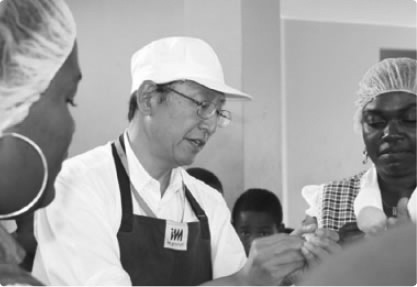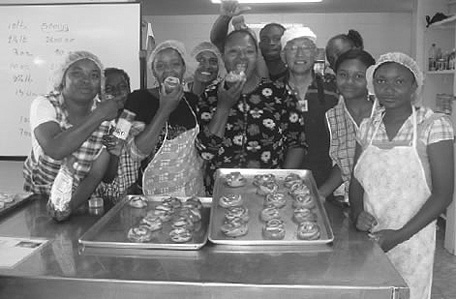Japan's Official Development Assistance White Paper 2011
Column 1
Bean Paste Buns Made in Ecuador!
—Project on Strengthening of the Occupational Training for the Vulnerable Sector—

Mr. Mitsushima teaching bread baking (Photo: JICA)
The South American republic of Ecuador is bisected north-to-south by the Andes. A third of its land features mountainous terrains. While the country enjoys an abundance of nature, the gap between rich and poor is a social issue, with 40% of the population living on less than 2 dollars a day. To change this situation, the government started accepting the socially vulnerable, such as refugees and people in indigenous communities and with disabilities, into courses offered by the Ecuadorean Occupational Training Service (Servicio Ecuatoriano de Capacitación Profesional—SECAP), whose objective is to eliminate poverty. From a lack of equipment and of experience and knowledge, however, this did not produce results as expected. And in 2008, JICA commenced support through the Project on Strengthening of Occupational Training for the Vulnerable Sector.
JICA expert Shiro Kikuchi, who serves as chief adviser of the project, says, "For lasting results, we need to choose methods that suit the region, the social background, the people's customs." And so the project conducted a survey of regional needs and adopted six fields: cooking, sewing, electrical work, construction, mechanical and metal work, and automobile servicing.
Hironao Mitsushima works in one of those fields—cooking. Mr. Mitsushima had obtained a bread-baking instructor's license while working as a company employee, later switched jobs and became a professional baker, and then joined JICA as a Senior Volunteer and began support activities in developing countries. Since 2010, he has been giving baking lessons in Ecuador's northern province of Imbabura.
"Everyday was a process of trial and error, as I had to make up recipes that used local ingredients. We didn't have fermentation equipment, so I invented a simplified version, covering the pan with aluminum foil and placing it with an electric heater to maintain temperature and humidity. Then, at last, we were able to make bread that was as fluffy as Japan's."
Mr. Mitsushima also devoted much energy to hygiene control. This was ever more important in rural settlements, which often did not have a water supply system or toilets. To train residents in Japanese methods of hygiene and quality control, Mr. Mitsushima used his imagination, posting photographs on cupboards of the equipment to be stored in them and devising cleaning plans, until the trainees mastered how to keep the kitchen tidy, orderly, and clean. "Although it's a lot of work, discovering different food cultures and baking techniques is always inspiring," says Mr. Mitsushima. His most impressive discovery was making Japanese-style bean paste buns with black beans in a poor African community in the village of Chalguayacu.
"Black beans are the village's sole crop. Chalguayacu's high altitude and low atmospheric pressure prevent the black beans from boiling as softly as azuki beans do in Japan. After failing many times, I used a pressure cooker and finally succeeded in making a paste that tasted almost like the fillings we use in Japan. Then there was another worry. The Ecuadoreans don't usually eat sweet boiled beans. I watched their reactions during the tasting, and was really happy when they smacked their lips and said the buns were delicious."
The residents of Chalguayacu who received training under Mr. Mitsushima are preparing to open a new bakery business. They even have an idea as to their feature product—bean paste buns coupled with a photograph of a soccer player born and raised in the village.
Mr. Mitsushima says, "Good food makes everyone smile. I want everyone to enjoy tasty food and be happy."

A tasting with trainees at Chalguayacu (Photo: Hironao Mitsushima)
